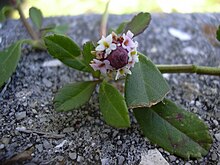| Fogfruits or frogfruits | |
|---|---|

| |
| Turkey tangle (P. nodiflora) with inflorescence | |
| Scientific classification | |
| Kingdom: | Plantae |
| Clade: | Tracheophytes |
| Clade: | Angiosperms |
| Clade: | Eudicots |
| Clade: | Asterids |
| Order: | Lamiales |
| Family: | Verbenaceae |
| Genus: | Phyla Lour. |
| Type species | |
| Phyla chinensis Lour. | |
| Species | |
|
See text | |
Phyla /ˈfaɪlə/ is a genus of eustarid plants in the verbena family, Verbenaceae. The name is derived from the Greek word φυλή (phyle), meaning "tribe", and most likely refers to the tightly clustered flowers or the spreading, mat-like growth. Members of the genus are known generally as fogfruit or frogfruit. Species once classified in the genus Lippia may be known by the common name lippia. Some species, e.g. Aztec Sweet Herb (P. dulcis), are used in cooking.
Selected species
- Phyla canescens (Kunth) Greene – hairy frogfruit/fogfruit
- Phyla chinensis Lour.
- Phyla cuneifolia (Torr.) Greene – wedgeleaf frogfruit/fogfruit, wedgeleaf
- Phyla dulcis (Trevir.) Moldenke, – Aztec sweet herb, honeyherb, hierba dulce (Spanish), tzopelic-xihuitl (Nahuatl)
- Phyla fruticosa (Mill.) Kennedy – diamondleaf frogfruit/fogfruit
- Phyla × intermedia Moldenke – intermediate frogfruit/fogfruit
- Phyla lanceolata (Michx.) Greene – lanceleaf frogfruit/fogfruit
- Phyla nodiflora (L.) Greene – turkey tangle, sawtooth frogfruit/fogfruit
- Phyla stoechadifolia (L.) Small – southern frogfruit/fogfruit
References
- "Phyla Lour". TROPICOS. Missouri Botanical Garden. Retrieved 2009-12-02.
- Kathleen N. Brenzel, ed. (1995). Sunset Western Garden Book (6 ed.). Sunset Publishing Corporation. pp. 606–607. ISBN 978-0-376-03851-7.
- Quattrocchi, Umberto (2012). CRC World Dictionary of Medicinal and Poisonous Plants. CRC Press. p. 2895. ISBN 978-1420080445.
- "Phyla". Integrated Taxonomic Information System. Retrieved 2013-04-25.
- "Subordinate Taxa of Phyla Lour". TROPICOS. Missouri Botanical Garden. Retrieved 2009-12-02.
- "GRIN Species Records of Phyla". Germplasm Resources Information Network. United States Department of Agriculture. Retrieved 2009-12-02.
External links
This Verbenaceae article is a stub. You can help Misplaced Pages by expanding it. |